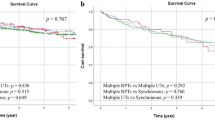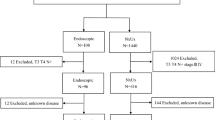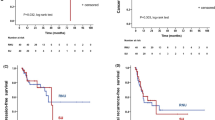Abstract
Multiple therapeutic options are available for the management of patients with upper urinary tract transitional cell carcinoma (TCC). Radical nephroureterectomy with an ipsilateral bladder cuff is the gold-standard therapy for upper-tract cancers. However, less invasive alternatives have a role in the treatment of this disease. Endoscopic management of upper-tract TCC is a reasonable strategy for patients with anatomic or functional solitary kidneys, bilateral upper-tract TCC, baseline renal insufficiency, and significant comorbid diseases. Select patients with a normal contralateral kidney who have small, low-grade lesions might also be candidates for endoscopic ablation. Distal ureterectomy is an option for patients with high-grade, invasive, or bulky tumors of the distal ureter not amenable to endoscopic management. In appropriately selected patients, outcomes following distal ureterectomy are similar to that of radical nephroureterectomy. Bladder cancer is a common occurrence following the management of upper-tract TCC. Currently, there are no variables that consistently predict which patients will develop intravesical recurrences. As such, surveillance with cystoscopy and cytology following surgical management of upper-tract TCC is essential. Extrapolating from data on bladder TCC, both regional lymphadenectomy and neoadjuvant chemotherapy regimens are likely to be beneficial for patients with upper-tract TCC, particularly in the setting of bulky disease.
Key Points
-
While upper-tract transitional cell carcinoma (TCC) accounts for only 5% of urothelial malignancies, evidence suggests that the frequency of these lesions is increasing
-
Radical nephroureterectomy by either the open or laparoscopic approach is the gold-standard therapy for upper-tract TCC; however, less invasive alternatives such as endoscopic ablation or segmental ureterectomy also have a role in treatment
-
Although TCC represents malignant degeneration of the urothelium, molecular and genetic studies indicate differences in the biologic mechanisms underlying upper-tract and bladder urothelial carcinoma
-
Bladder cancer occurs in 15–50% of patients following upper-tract TCC, underscoring the necessity for regular postoperative interval cystoscopy and urinary cytology
-
Experience gained from the management of bladder TCC suggests that both neoadjuvant chemotherapy and regional lymphadenectomy should both have a role in the management of upper-tract TCC
This is a preview of subscription content, access via your institution
Access options
Subscribe to this journal
Receive 12 print issues and online access
$209.00 per year
only $17.42 per issue
Buy this article
- Purchase on Springer Link
- Instant access to full article PDF
Prices may be subject to local taxes which are calculated during checkout


Similar content being viewed by others
References
Jemal A et al. (2005) Cancer statistics, 2005. CA Cancer J Clin 55: 10–30
Munoz JJ et al. (2000) Upper tract urothelial neoplasms: incidence and survival during the last 2 decades. J Urol 164: 1523–1525
Houston RH et al. (2005) Management of Upper Tract Tumors. In Comprehensive Textbook of Genitourinary Oncology, edn 3 vol. 1, 435–442 (Eds Vogelzang NJ et al.) Philadelphia: Lippincott Williams & Wilkins
Palvio DH et al. (1987) Transitional cell tumors of the renal pelvis and ureter associated with capillarosclerosis indicating analgesic abuse. Cancer 59: 972–976
Jensen OM et al. (1988) The Copenhagen case-control study of renal pelvis and ureter cancer: role of smoking and occupational exposures. Int J Cancer 41: 557–561
Auld CD et al. (1984) Histopathological review of transitional cell carcinoma of the upper urinary tract. Br J Urol 56: 485–489
McCarron JP et al. (1983) Tumors of the renal pelvis and ureter: current concepts and management. Semin Urol 1: 75–81
Zincke H et al. (1976) Significance of urinary cytology in the early detection of transitional cell cancer of the upper urinary tract. J Urol 116: 781–783
Grace DA et al. (1967) Carcinoma of the renal pelvis: a 15-year review. J Urol 98: 566–569
Guarnizo E et al. (2000) Ureteroscopic biopsy of upper tract urothelial carcinoma: improved diagnostic accuracy and histopathological considerations using a multi-biopsy approach. J Urol 163: 52–55
Keeley FX et al. (1997) Diagnostic accuracy of ureteroscopic biopsy in upper tract transitional cell carcinoma. J Urol 157: 33–37
Simoneau M et al. (1999) Four tumor suppressor loci on chromosome 9q in bladder cancer: evidence for two novel candidate regions at 9q22.3 and 9q31. Oncogene 18: 157–163
Czerniak B et al. (1999) Superimposed histologic and genetic mapping of chromosome 9 in progression of human urinary bladder neoplasia: implications for a genetic model of multistep urothelial carcinogenesis and early detection of urinary bladder cancer. Oncogene 18: 1185–1196
Cairns P et al. (1991) Loss of heterozygosity at the RB locus is frequent and correlates with muscle invasion in bladder carcinoma. Oncogene 6: 2305–2309
Cote RJ et al. (1998) Elevated and absent pRb expression is associated with bladder cancer progression and has cooperative effects with p53. Cancer Res 58: 1090–1094
Harris CC et al. (1993) Clinical implications of the p53 tumor-suppressor gene. N Engl J Med 329: 1318–1327
Cordon-Cardo C et al. (1997) Cooperative effects of p53 and pRB alterations in primary superficial bladder tumors. Cancer Res 57: 1217–1221
Catto JW et al. (2007) Behavior of urothelial carcinoma with respect to anatomical location. J Urol 177: 1715–1720
Park S et al. (2004) The impact of tumor location on prognosis of transitional cell carcinoma of the upper urinary tract. J Urol 171: 621–625
Catto JW et al. (2003) Distinct patterns of microsatellite instability are seen in tumours of the urinary tract. Oncogene 22: 8699–8706
Roupret M et al. (2005) Microsatellite instability as predictor of survival in patients with invasive upper urinary tract transitional cell carcinoma. Urology 65: 1233–1237
Roupret M et al. (2004) Microsatellite instability as indicator of MSH2 gene mutation in patients with upper urinary tract transitional cell carcinoma. J Med Genet 41: e91
Fromont G et al. (2005) Tissue microarray analysis of the prognostic value of E-cadherin, Ki67, p53, p27, survivin and MSH2 expression in upper urinary tract transitional cell carcinoma. Eur Urol 48: 764–770
Zigeuner R et al. (2004) Prognostic impact of p63 and p53 expression in upper urinary tract transitional cell carcinoma. Urology 63: 1079–1083
Flanigan RC (2007) Urothelial tumors of the upper urinary tract. In Campbell-Walsh Urology, edn 9 vol. 2, 1638–1652 (Eds Wein A et al.) Philadelphia: WB Saunders
Gerber GS et al. (1999) Endourologic treatment of renal pelvic and ureteral transitional cell carcinoma. Tech Urol 5: 77–80
Sagalowsky A et al. (2007) Management of Urothelial Tumors of the Renal Pelvis and Ureter. In: Campbell-Walsh Urology, edn 9 vol. 2, 1653–1687 (Eds Wein A et al.) Philadelphia: WB Saunders
Daneshmand S et al. (2003) Endoscopic management of upper urinary tract transitional cell carcinoma: long-term experience. Cancer 98: 55–60
Keeley FX Jr et al. (1997) Ureteroscopic treatment and surveillance of upper urinary tract transitional cell carcinoma. J Urol 157: 1560–1565
Martinez-Pineiro JA et al. (1996) Endourological treatment of upper tract urothelial carcinomas: analysis of a series of 59 tumors. J Urol 156: 377–385
Elliott DS et al. (1996) Long-term follow-up of endoscopically treated upper urinary tract transitional cell carcinoma. Urology 47: 819–825
Smith JA Jr (1993) Review: tissue effects of laser energy. J Endourol 7: 389–390
Huang A et al. (1995) Nephrostomy tract tumor seeding following percutaneous manipulation of a ureteral carcinoma. J Urol 153: 1041–1042
Yamada Y et al. (2002) Nephrostomy tract tumor seeding following percutaneous manipulation of a renal pelvic carcinoma. Hinyokika Kiyo 48: 415–418
Jarrett TW et al. (1995) Percutaneous management of transitional cell carcinoma of the renal collecting system: 9-year experience. J Urol 154: 1629–1635
Clark PE et al. (1999) 13-year experience with percutaneous management of upper tract transitional cell carcinoma. J Urol 161: 772–775
Patel A et al. (1996) Long-term outcome after percutaneous treatment of transitional cell carcinoma of the renal pelvis. J Urol 155: 868–874
Tawfiek ER et al. (1997) Upper-tract transitional cell carcinoma. Urology 50: 321–329
Chen GL et al. (2000) Ureteroscopic management of upper tract transitional cell carcinoma in patients with normal contralateral kidneys. J Urol 164: 1173–1176
Elliott DS et al. (2001) Is nephroureterectomy necessary in all cases of upper tract transitional cell carcinoma? Long-term results of conservative endourologic management of upper tract transitional cell carcinoma in individuals with a normal contralateral kidney. Urology 58: 174–178
Grasso M et al. (1999) Ureteropyeloscopic diagnosis and treatment of upper urinary tract urothelial malignancies. Urology 54: 240–246
Patel A et al. (1998) New techniques for the administration of topical adjuvant therapy after endoscopic ablation of upper urinary tract transitional cell carcinoma. J Urol 159: 71–75
Soderdahl DW et al. (2005) Endoscopic treatment of upper tract transitional cell carcinoma. Urol Oncol 23: 114–122
Boorjian S et al. (2005) Impact of delay to nephroureterectomy for patients undergoing ureteroscopic biopsy and laser tumor ablation of upper tract transitional cell carcinoma. Urology 66: 283–287
Okada H et al. (1997) Percutaneous treatment of transitional cell carcinoma of the upper urinary tract. Int J Urol 4: 130–133
Roupret M et al. (2007) Upper urinary tract transitional cell carcinoma: recurrence rate after percutaneous endoscopic resection. Eur Urol 51: 709–713
Lee BR et al. (1999) 13-year survival comparison of percutaneous and open nephroureterectomy approaches for management of transitional cell carcinoma of renal collecting system: equivalent outcomes. J Endourol 13: 289–294
Mukamel E et al. (1991) The effect of intravesical bacillus Calmette-Guerin therapy on the upper urinary tract. J Urol 146: 980–981
Bellman GC et al. (1994) Complications of intracavitary bacillus Calmette-Guerin after percutaneous resection of upper tract transitional cell carcinoma. J Urol 151: 13–15
Orihuela E et al. (1988) Percutaneous treatment of transitional cell carcinoma of the upper urinary tract. Urol Clin North Am 15: 425–431
Thalmann GN et al. (2002) Long-term experience with bacillus Calmette-Guerin therapy of upper urinary tract transitional cell carcinoma in patients not eligible for surgery. J Urol 168: 1381–1385
Hayashida Y et al. (2004) Long-term effects of bacille Calmette-Guerin perfusion therapy for treatment of transitional cell carcinoma in situ of upper urinary tract. Urology 63: 1084–1088
Mazeman E (1976) Tumours of the upper urinary tract calyces, renal pelvis and ureter. Eur Urol 2: 120–126
Zincke H et al. (1984) Feasibility of conservative surgery for transitional cell cancer of the upper urinary tract. Urol Clin North Am 11: 717–724
Ziegelbaum M et al. (1987) Conservative surgery for transitional cell carcinoma of the renal pelvis. J Urol 138: 1146–1149
Roupret M et al. (2007) Laparoscopic distal ureterectomy and anastomosis for management of low-risk upper urinary tract transitional cell carcinoma: preliminary results. BJU Int 99: 623–627
Uberoi J et al. (2007) Robot-assisted laparoscopic distal ureterectomy and ureteral reimplantation with psoas hitch. J Endourol 21: 368–373
Anderstrom C et al. (1989) Carcinoma of the ureter: a clinicopathologic study of 49 cases. J Urol 142: 280–283
Zungri E et al. (1990) Treatment of transitional cell carcinoma of the ureter: is the controversy justified? Eur Urol 17: 276–280
Maier U et al. (1990) Organ-preserving surgery in patients with urothelial tumors of the upper urinary tract. Eur Urol 18: 197–200
Johnson DE et al. (1979) Conservative surgical management for noninvasive distal ureteral carcinoma. Urology 13: 365–367
Babaian RJ et al. (1980) Primary carcinoma of the ureter. J Urol 123: 357–359
Batata M et al. (1976) Upper urinary tract urothelial tumors. Urol Clin North Am 3: 79–86
Abercrombie GF et al. (1988) Modified nephro-ureterectomy. Long-term follow-up with particular reference to subsequent bladder tumours. Br J Urol 61: 198–200
Weise ES et al. (2005) Laparoscopic management of upper tract tumors. In Comprehensive Textbook of Genitourinary Oncology vol. 1, 442–447 (Eds Vogelzang NJ et al.) Philadelphia: Lippincott Williams & Wilkins
Arango O et al. (1997) Massive tumor implantation in the endoscopic resected area in modified nephroureterectomy. J Urol 157: 1839
Palou J et al. (2000) Management of superficial transitional cell carcinoma in the intramural ureter: what to do? J Urol 163: 744–747
Jones DR et al. (1993) A cautionary tale of the modified “pluck” nephroureterectomy. Br J Urol 71: 486
Hetherington JW et al. (1986) Modified nephroureterectomy: a risk of tumour implantation. Br J Urol 58: 368–370
Wong C et al. (2002) Hand-assisted laparoscopic nephroureterectomy with cystoscopic en bloc excision of the distal ureter and bladder cuff. J Endourol 16: 329–332
Kurzer E et al. (2006) Combining hand assisted laparoscopic nephroureterectomy with cystoscopic circumferential excision of the distal ureter without primary closure of the bladder cuff—is it safe? J Urol 175: 63–67
Giovansili B et al. (2004) Stripping technique for endoscopic management of distal ureter during nephroureterectomy: experience of 32 procedures. Urology 64: 448–452
Gill IS et al. (1999) A novel technique for management of the en bloc bladder cuff and distal ureter during laparoscopic nephroureterectomy. J Urol 161: 430–434
Stifelman MD et al. (2000) Hand-assisted laparoscopic nephroureterectomy for the treatment of transitional cell carcinoma of the upper urinary tract. Urology 56: 741–747
Gonzalez CM et al. (2001) A novel endoscopic approach towards resection of the distal ureter with surrounding bladder cuff during hand assisted laparoscopic nephroureterectomy. J Urol 165: 483–485
Hall MC et al. (1998) Prognostic factors, recurrence, and survival in transitional cell carcinoma of the upper urinary tract: a 30-year experience in 252 patients. Urology 52: 594–601
Jarrett TW et al. (2001) Laparoscopic nephroureterectomy for the treatment of transitional cell carcinoma of the upper urinary tract. Urology 57: 448–453
McNeill SA et al. (2000) The long-term outcome after laparoscopic nephroureterectomy: a comparison with open nephroureterectomy. BJU Int 86: 619–623
Seifman BD et al. (2001) Prospective comparison between hand-assisted laparoscopic and open surgical nephroureterectomy for urothelial cell carcinoma. Urology 57: 133–137
Raman JD et al. (2006) Hand-assisted laparoscopic nephroureterectomy for the management of upper urinary tract transitional cell carcinoma: duplicating the open approach. JSLS 10: 432–438
Roupret M et al. (2007) Oncologic control after open or laparoscopic nephroureterectomy for upper urinary tract transitional cell carcinoma: a single center experience. Urology 69: 656–661
Manabe D et al. (2007) Comparative study of oncologic outcome of laparoscopic nephroureterectomy and standard nephroureterectomy for upper urinary tract transitional cell carcinoma. Urology 69: 457–461
Landman J et al. (2002) Comparison of hand assisted and standard laparoscopic radical nephroureterectomy for the management of localized transitional cell carcinoma. J Urol 167: 2387–2391
El Fettouh HA et al. (2002) Laparoscopic radical nephroureterectomy: results of an international multicenter study. Eur Urol 42: 447–452
Gill IS et al. (2000) Laparoscopic radical nephroureterectomy for upper tract transitional cell carcinoma: the Cleveland Clinic experience. J Urol 164: 1513–1522
Shalhav AL et al. (2000) Laparoscopic nephroureterectomy for upper tract transitional cell cancer: the Washington University experience. J Urol 163: 1100–1104
Stein JP et al. (2005) The role of lymphadenectomy in high-grade invasive bladder cancer. Urol Clin North Am 32: 187–197
Kondo T et al. (2007) Primary site and incidence of lymph node metastases in urothelial carcinoma of upper urinary tract. Urology 69: 265–269
Raman JD et al. (2005) Bladder cancer after managing upper urinary tract transitional cell carcinoma: predictive factors and pathology. BJU Int 96: 1031–1035
Krogh J et al. (1991) Transitional cell carcinoma of the upper urinary tract: prognostic variables and post-operative recurrences. Br J Urol 67: 32–36
Hisataki T et al. (2000) Risk factors for the development of bladder cancer after upper tract urothelial cancer. Urology 55: 663–667
Koga F et al. (2001) Risk factors for the development of bladder transitional cell carcinoma following surgery for transitional cell carcinoma of the upper urinary tract. Urol Int 67: 135–141
Kang CH et al. (2003) The development of bladder tumors and contralateral upper urinary tract tumors after primary transitional cell carcinoma of the upper urinary tract. Cancer 98: 1620–1626
Wolf JS Jr et al. (2005) Intermediate followup of hand assisted laparoscopic nephroureterectomy for urothelial carcinoma: factors associated with outcomes. J Urol 173: 1102–1107
Raman JD et al. (2007) Pathologic features of bladder tumors after nephroureterectomy or segmental ureterectomy for upper urinary tract transitional cell carcinoma. Urology 69: 251–254
Oldbring J et al. (1989) Carcinoma of the renal pelvis and ureter following bladder carcinoma: frequency, risk factors and clinicopathological findings. J Urol 141: 1311–1313
Solsona E et al. (1997) Upper urinary tract involvement in patients with bladder carcinoma in situ (Tis): its impact on management. Urology 49: 347–352
Rabbani F et al. (2001) Upper-tract tumors after an initial diagnosis of bladder cancer: argument for long-term surveillance. J Clin Oncol 19: 94–100
Herr HW et al. (1992) Bacillus Calmette-Guerin therapy for superficial bladder cancer: a 10-year followup. J Urol 147: 1020–1023
Herr HW et al. (1996) Upper tract tumors in patients with primary bladder cancer followed for 15 years. J Urol 156: 1286–1287
Herr HW (1997) Natural history of superficial bladder tumors: 10- to 20-year follow-up of treated patients. World J Urol 15: 84–88
Zincke H et al. (1984) Upper urinary tract transitional cell cancer after radical cystectomy for bladder cancer. J Urol 131: 50–52
Canfield SE et al. (2003) Surveillance and management of recurrence for upper tract transitional cell carcinoma. Urol Clin North Am 30: 791–802
Grossman HB et al. (2003) Neoadjuvant chemotherapy plus cystectomy compared with cystectomy alone for locally advanced bladder cancer. N Engl J Med 349: 859–866
[No authors listed] (1999) Neoadjuvant cisplatin, methotrexate, and vinblastine chemotherapy for muscle-invasive bladder cancer: a randomised controlled trial. International collaboration of trialists. Lancet 354: 533–540
Roberts JT et al. (2006) Long-term survival results of a randomized trial comparing gemcitabine/cisplatin and methotrexate/vinblastine/doxorubicin/cisplatin in patients with locally advanced and metastatic bladder cancer. Ann Oncol 17 (Suppl 5): v118–v122
[No authors listed] (2002) Renal pelvis and ureter. In American Joint Committee on Cancer: AJCC Cancer Staging Manual, edn 6, 329–334 (Eds Greene FL et al.) New York: Springer
Author information
Authors and Affiliations
Corresponding author
Ethics declarations
Competing interests
The authors declare no competing financial interests.
Rights and permissions
About this article
Cite this article
Raman, J., Scherr, D. Management of patients with upper urinary tract transitional cell carcinoma. Nat Rev Urol 4, 432–443 (2007). https://doi.org/10.1038/ncpuro0875
Received:
Accepted:
Issue Date:
DOI: https://doi.org/10.1038/ncpuro0875
This article is cited by
-
Salvage topical therapy for upper tract urothelial carcinoma
World Journal of Urology (2018)
-
Complications Following Radical Nephroureterectomy
Current Urology Reports (2016)
-
Prognostic value of systemic inflammatory responses in patients with upper urinary tract urothelial carcinoma
World Journal of Urology (2015)
-
Extraurothelial recurrence after radical nephroureterectomy: preoperative predictors and survival
International Urology and Nephrology (2015)
-
Prognostic impact of the expression of ALDH1 and SOX2 in urothelial cancer of the upper urinary tract
Modern Pathology (2013)



